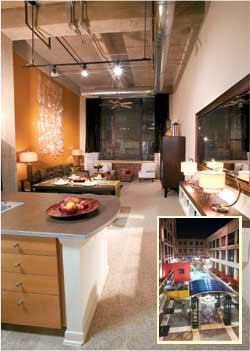Industrial Chic “Welcome to Downtown Houston” announces the sign on U.S. 59. The next sight to catch your eye may be the five-story, early 20th-century warehouse, variously referred to as the Nabisco Building and the Purse Building. When it was first completed in 1910, the Nabisco Building was one of a handful of structures with an identical design commissioned by the National Biscuit Company for locations across the U.S. Used as factories and warehouses, these buildings were designed with one solid brick wall, against which commercial baking ovens could be placed, and three other sides with banks of windows to provide ventilation.
Silvestri Investments purchased the property through bankruptcy court and is working with co-developer Reuther Investment to convert it to condominiums. Tentatively titled Cityview Lofts, the building will include 57 units including 10 hard lofts—studio spaces with no dividing walls. The building, just blocks from the Houston Astros’ Minute Maid Park, and the downtown hub, is an up-and-coming neighborhood with a funky feel. It features a well-known Mexican restaurant, art studios, and a homeless shelter. Silvestri hopes to attract first-time buyers in their late twenties and early thirties, with most of the units affordably priced at $200,000.
According to Reuther president J.R. Reuther, maintaining the industrial look also will help appeal to young buyers. “We’re leaving it as rough as we possibly can,” he says of the building. Although the original facade will remain intact, the developers are making some changes. For instance, the solid brick wall faces west, which is the direction with the desirable downtown views. Aesthetically compatible windows and wrought iron balconies will be added to that wall. These changes make the building ineligible for historic tax credits, since they alter its original look, but Reuther says the loss is more than offset by the increased value brought by the views.
Inside the building, the developers are emphasizing features of historic interest, to create an almost museum-like feel. Every unit will feature high ceilings and refinished wood floors. The original sprinkler system, installed in 1954 and including lots of exposed galvanized pipe, will be left intact and refurbished. Staircases will showcase iron cannonball posts and unique ironwork railings. A cavernous downstairs storage area, once part of the loading dock, will house the building’s lounge. As a reminder of its original purpose, blowups of old photos will be displayed prominently in the lobby.
While unique touches like these add to the charm of the property, the solidity of this turn-of-the-century building—including structural features like three-foot-thick sub floors—is another real selling point. “You could never build something like this today,” says Reuther.
